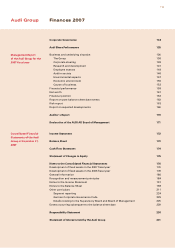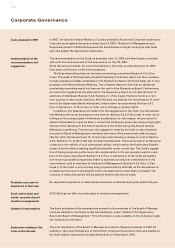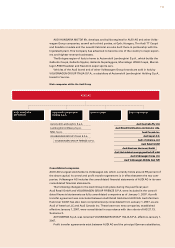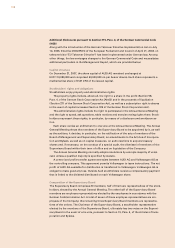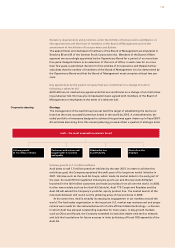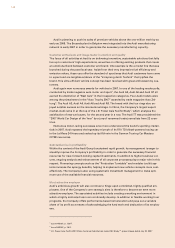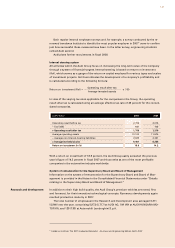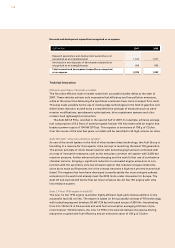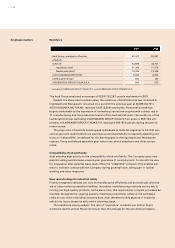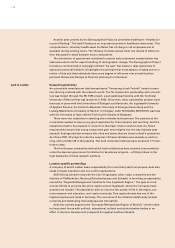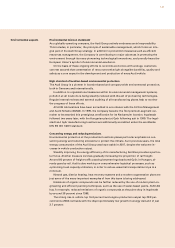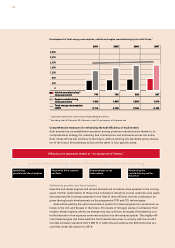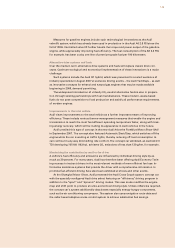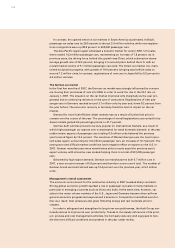Audi 2007 Annual Report Download - page 145
Download and view the complete annual report
Please find page 145 of the 2007 Audi annual report below. You can navigate through the pages in the report by either clicking on the pages listed below, or by using the keyword search tool below to find specific information within the annual report.
142
Research and development expenditure recognized as an expense
EUR million 2007 2006
Research expenditure and development expenditure not
recognized as an intangible asset 1,570 1,077
Amortization and disposals of development expenditure
recognized as an intangible asset 656 905
Total research and development expenditure recognized
as an expense 2,226 1,982
Technical innovations
Efficient sportiness: The Audi e models
The first ultra-efficient Audi e models made their successful market debut at the start of
2007. These vehicles achieve truly impressive fuel efficiency and low pollution emissions,
while at the same time delivering the sportiness customers have come to expect from Audi.
This was made possible by the use of cutting-edge technologies in the field of gasoline and
diesel direct injection, as well as by a comprehensive package of measures such as trans-
mission modifications, aerodynamic optimizations, driver assistance systems and ultra-
modern Audi lightweight construction.
The Audi A8 2.8 FSI e, unveiled in the second half of 2007, for example, achieves average
fuel consumption of 8.3 liters of premium-grade fuel per 100 kilometers with an engine that
boasts a power output of 154 kW (210 hp). This equates to emissions of 199 g of CO2/km.
Over the course of the next few years, e models will be launched in all high-volume car lines.
Audi TDI with “ultra low emission system”
As one of the world leaders in the field of ultra-modern diesel technology, the Audi Group is
heralding in a new era for this superior drive concept in launching the latest TDI generation.
The proven principle of direct diesel injection with turbocharging has been combined with
an array of innovative measures, such as the new piezo common rail system with 2,000-bar
injection pressure, further enhanced turbocharging and the world’s first use of combustion
chamber sensors, bringing a significant reduction in untreated engine emissions. In con-
junction with the secondary ultra low emission system that reduces nitrogen oxide emis-
sions by as much as 90 percent, the drive concept becomes a high-tech yet very economical
diesel. The engines that have been developed currently satisfy the most stringent exhaust
emissions in the world and already meet the 2014 limits under discussion for Europe. The
Audi Q7 and Audi A4 will be the first car lines to feature the 3.0 liter TDI engine with ultra
low emission system.
New 1.4 liter TFSI engine in Audi A3
The new 1.4 liter TFSI engine is another highly efficient, high-performance addition to the
successful Audi A3 car line. The engine is based on the successful concept of FSI technology
with turbocharging and develops 92 kW (125 hp) with peak torque of 200 Nm. Accelerating
from 0 to 100 km/h in 9.6 seconds and with fuel consumption averaging 6.5 liters of pre-
mium fuel per 100 kilometers, the new 1.4 TFSI in the Audi A3 delivers impressive driving
enjoyment coupled with fuel efficiency and an emissions value of 154 g of CO2/km.



